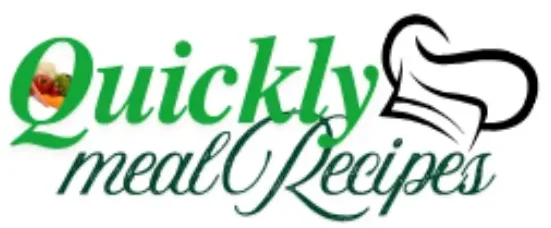Table of Contents
The first time I mixed these two treasures in my kitchen, I knew I’d found something special. The tender scallops and the juicy shrimp together make any dish amazing.
My love for seafood recipes started years ago. But it was when I combined these shellfish that my cooking really improved. They soak up flavors well, whether in a creamy sauce, grilled, or in a zesty marinade.
What’s great about these shellfish recipes is how versatile they are. They cook fast, perfect for quick weeknight meals or fancy dinners. I’ve spent many nights learning how to make them taste their best.
In this guide, I’ll share my top picks that are loved at home. You’ll learn about picking the freshest ingredients and cooking them right. It’s all about respecting these delicate sea treasures.
Whether you’re a seasoned chef or just starting out, these shrimp and scallop recipes will impress. They make it easy to serve restaurant-quality meals at home.
Key Takeaways
- Combining shrimp and scallops creates elevated dishes with complementary flavors and textures
- These shellfish cook quickly, making them ideal for both weeknight meals and special occasions
- Fresh seafood selection is crucial for achieving the best flavor in your dishes
- Both ingredients readily absorb flavors from marinades, sauces, and seasonings
- Proper cooking techniques prevent overcooking these delicate shellfish
- These versatile ingredients work in multiple cuisines from Italian pasta to spicy stir-fries
The Allure of Shellfish in Modern Cuisine
Shellfish, like shrimp and scallops, are highly respected in today’s cooking world. They’ve moved from being rare treats to common kitchen staples in America. Their flexibility makes them great for many shellfish recipes, from quick dinners to fancy dinner parties.
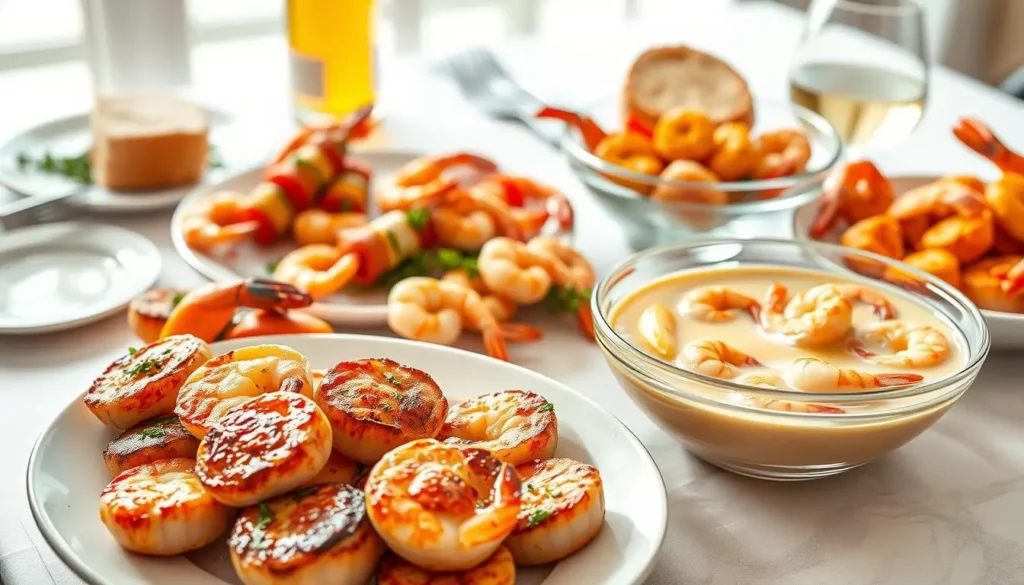
The appeal of shellfish goes beyond taste. They’re also easy to use and versatile. They’re perfect for adding protein to pasta or as the main attraction in stir-fries. This is why scallops and shrimp recipes main course are so popular today.
Nutritional Benefits of Shrimp and Scallops
Shellfish are not only tasty but also nutritious. Shrimp is a good source of protein, selenium, and vitamin B12, with fewer calories. A 3-ounce serving has about 20 grams of protein and only 84 calories.
Scallops add to this nutritional value with their own set of nutrients. They’re rich in protein, vitamin B12, zinc, and omega-3 fatty acids. Together, they support heart health and overall well-being.
Adding these shellfish to your meals is a tasty way to keep your diet balanced. It doesn’t mean you have to give up flavor or satisfaction.
Why These Seafoods Make a Perfect Pairing
Many wonder, “can shrimp and scallops be cooked together?” The answer is yes! Their nutritional benefits work well together. Plus, their textures and flavors complement each other perfectly.
Shrimp has a subtle sweetness, while scallops are sweeter with a nutty taste. This mix makes shrimp and scallops recipes main course stand out.
Both seafoods cook well together and absorb flavors easily. They’re great in many dishes, from Mediterranean to Asian. This is why they’re often paired in shellfish recipes.
Essential Tools and Ingredients for Perfect Shellfish Dishes
Creating top-notch shrimp and scallop dishes starts with the right tools and ingredients. After years of cooking seafood at home, I’ve learned that the right equipment makes a big difference. Here’s what I think is essential for anyone wanting to improve their shellfish cooking.
Kitchen Equipment You’ll Need
Investing in proper tools made my seafood cooking much better. A heavy-bottomed skillet is key for a perfect sear on scallops. Stainless steel or cast iron pans are best for their heat retention.
For quick shrimp dishes, a wide, shallow pan is best. It allows for even cooking without overcrowding. This prevents the shrimp from steaming instead of sautéing, which can make them rubbery.
- Seafood shears or kitchen scissors for deveining shrimp
- Fish spatula with a thin, flexible edge for delicate handling
- Kitchen tweezers for removing shells and sand veins
- Instant-read thermometer to prevent overcooking
- Parchment paper for easy cleanup when baking seafood
- Mixing bowls in various sizes for marinades and preparations
Having these tools ready makes cooking less stressful and more enjoyable. When deciding whether scallops are better fried or boiled, the right pan is crucial. Properly seared scallops in a quality skillet always win over boiled ones.
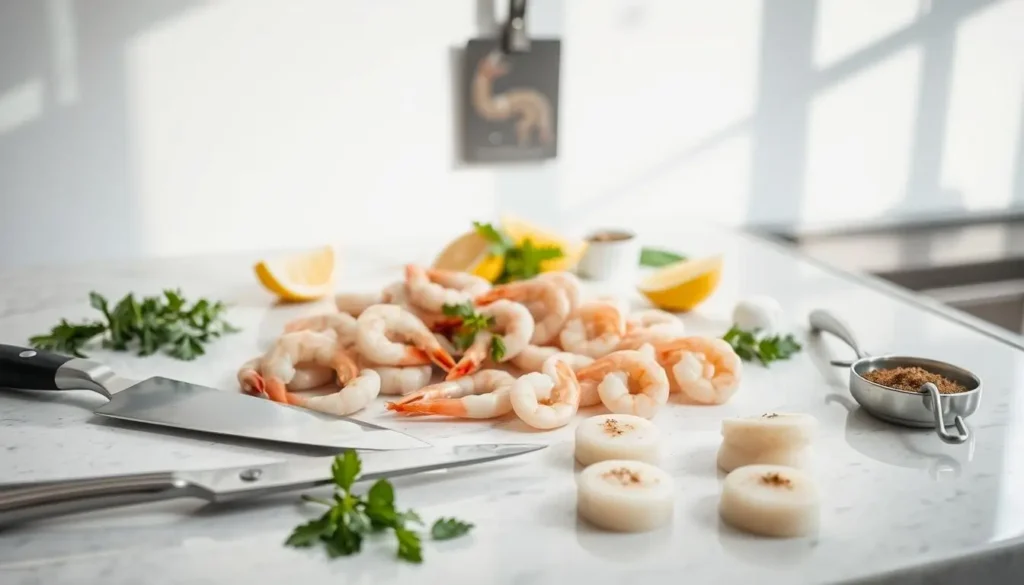
Pantry Staples for Seafood Cooking
Shellfish is best when its natural flavors are enhanced by the right ingredients. I keep my pantry stocked with items that complement the taste of shrimp and scallops without overpowering it.
Quality fats are the base of most seafood dishes in my kitchen. I always have extra virgin olive oil for cooking and finishing, along with unsalted butter for rich, silky sauces that pair well with shellfish.
- Fresh garlic and shallots for aromatic bases
- Lemons for brightness and acidity
- Dry white vinegar (Sauvignon Blanc or Pinot Grigio) for deglazing
- Dijon mustard for adding depth to sauces
- Capers for briny, tangy notes
- Fresh herbs like parsley, dill, and tarragon
For those wondering what dishes go well with scallops, having these pantry staples lets me create simple garlic butter dishes or more complex ones like seafood risotto or pasta with white vinegar sauce.
For Asian-inspired flavors, I use soy sauce, sesame oil, rice vinegar, and fresh ginger. These ingredients turn ordinary shellfish into exotic dishes with little effort.
Fresh vs. Frozen Seafood: Making the Right Choice
The debate between fresh and frozen seafood is one I’ve explored thoroughly. Frozen seafood is often better for home cooks. This might seem odd, but there’s good reason for it.
Many “fresh” seafood items at supermarkets have been previously frozen and thawed. High-quality flash-frozen shrimp and scallops are preserved at peak freshness, locking in flavor and texture.
| Consideration | Fresh Seafood | Frozen Seafood | Best For |
|---|---|---|---|
| Availability | Seasonal, limited | Year-round, consistent | Frozen for reliability |
| Quality Control | Variable, depends on source | Consistent if flash-frozen | IQF (individually quick frozen) |
| Convenience | Must use quickly | Extended storage possible | Frozen for meal planning |
| Cost | Generally higher | More economical | Frozen for budget cooking |
| Taste & Texture | Excellent when truly fresh | Very good with proper thawing | Truly fresh or properly frozen |
When buying frozen seafood, look for IQF products without added preservatives or sodium solutions. This ensures you get pure seafood that cooks beautifully in your easy shrimp and scallop recipes.
If you choose fresh seafood, use your senses as guides. Look for shrimp with firm, translucent flesh and scallops with a sweet, clean ocean smell. The color should be consistent without browning or discoloration.
Whether you choose fresh or frozen, proper handling is key. Always thaw frozen seafood slowly in the refrigerator, not under warm water. This preserves the quality and ensures your shellfish dishes turn out perfectly every time.
Selecting and Preparing Fresh Shellfish
Finding the best shrimp and scallops dishes starts with picking top-notch seafood. I’ve learned that even the best recipes can’t make up for bad ingredients. Freshness is key for taste, safety, and texture.
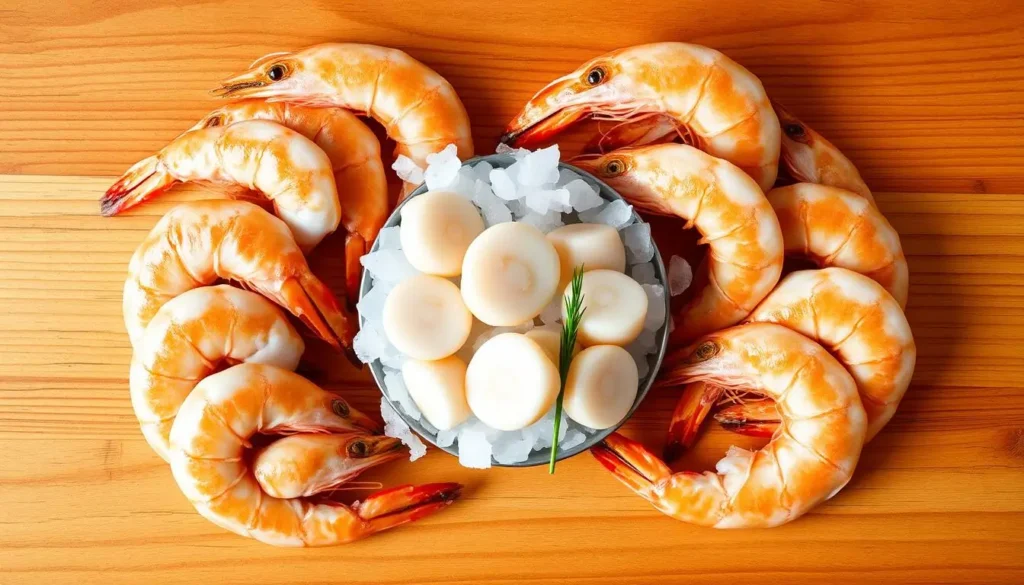
How to Choose Quality Shrimp
At the seafood counter, I look for shrimp with certain signs of freshness. The shells should be firm and shiny, without black spots or yellow edges. These signs mean the shrimp are old or handled badly.
The smell is also crucial. Fresh shrimp should smell like the ocean, not like ammonia or fish. If it smells bad, don’t buy it.
Choosing the right size shrimp depends on your recipe. Here’s a simple guide:
- Large shrimp (16-20 count): Great for grilling and fancy dishes
- Medium shrimp (21-30 count): Good for pasta and stir-fries
- Small shrimp (31-40 count): Best for salads and stuffings
I choose wild-caught shrimp when I can. They taste better, but farmed shrimp can be good too.
Selecting Perfect Scallops
Scallops come in two types, each for different dishes. Sea scallops are big and perfect for main courses. Bay scallops are smaller, sweeter, and great in pasta and risottos.
Good scallops look a certain way. They should be slightly clear and white or light beige. Avoid very white scallops, as they might be treated with chemicals.
I prefer dry-packed scallops for better flavor and searing. They cost more but are worth it. They should smell sweet and ocean-like.
Proper Cleaning and Preparation Techniques
Preparing shrimp involves deciding to keep or remove the shells. For most recipes, I remove them, keeping the tails for looks. It’s important to devein them with a small knife.
Scallops are simpler to prepare. Some ask, why soak scallops in milk before cooking? It helps with grit and flavor, but fresh scallops don’t need it.
Instead, dry scallops well with paper towels before cooking. This helps get a nice sear. Moisture ruins caramelization.
Here are some don’ts for both shellfish:
- Don’t rinse under water—it loses flavor
- Avoid handling too much to keep them soft
- Bring them to room temperature before cooking
These steps might seem detailed, but they’re key for great shrimp and scallops dishes. Spending time on these steps makes a big difference in the final dish.
Mastering Basic Cooking Techniques for Shellfish
Mastering a few basic cooking techniques can make a big difference in shellfish dishes. Shrimp and scallops can become tender and flavorful if cooked right. I’ve learned a lot about cooking these delicate ingredients to perfection.
Sautéing Shrimp and Scallops to Perfection
Sautéing is a great way to cook shellfish because it’s quick and flavorful. I start with a hot pan and mix butter and oil. The oil helps prevent the butter from burning while adding flavor.
It’s important not to overcrowd the pan. Arrange shrimp in a single layer for even cooking. This prevents steaming and keeps the seafood tender.
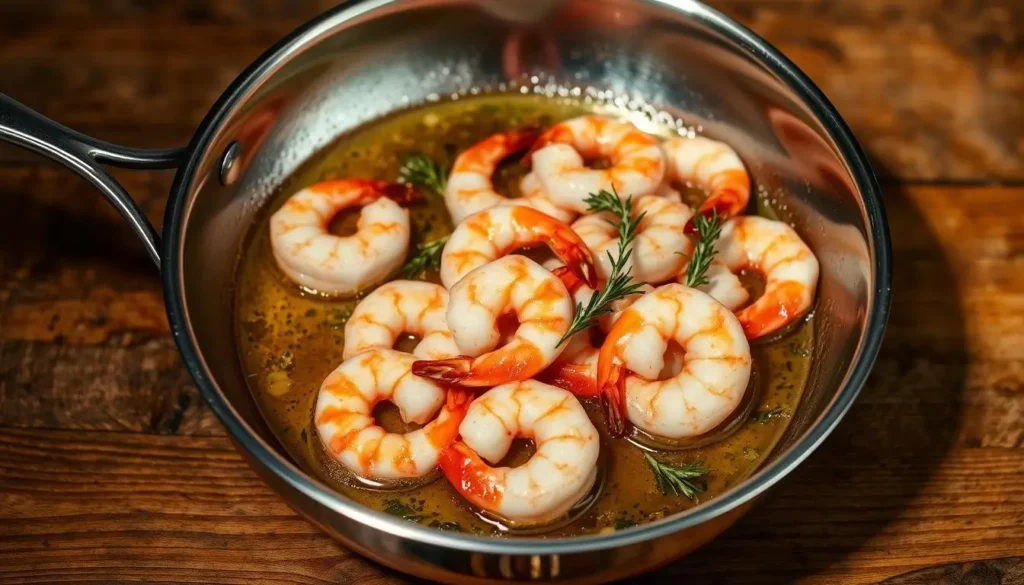
To sauté shrimp perfectly, cook them for 2 minutes on each side. They should turn pink and slightly curl. Timing is key – a “C” shape is perfect, while a tight “O” shape means they’re overcooked.
The Art of Properly Searing Scallops
Searing scallops is an art that makes them caramelized and tender. Start by patting them dry to remove excess moisture.
Heat a heavy pan until it’s very hot. Add oil and butter. The pan must be hot enough for the scallops to sizzle when added. Place each scallop in the pan without crowding.
Be patient when searing. Let the scallops cook for 2-3 minutes on the first side. Flip them once and cook for another 1-2 minutes. They should be slightly translucent in the center.
Should You Cook Scallops or Shrimp First?
When cooking both scallops and shrimp, it’s best to start with scallops. They need high heat and precise timing.
After searing the scallops, add the shrimp to the pan. This way, the shrimp absorb the flavorful fond left by the scallops.
If you need to serve both together, slightly undercook the scallops. Cook the shrimp, then return the scallops for a minute. This ensures both are cooked perfectly together.
| Cooking Technique | Best For | Cooking Time | Key Success Factors |
|---|---|---|---|
| Sautéing | Both shrimp and scallops | 2-3 minutes per side | Hot pan, don’t overcrowd, butter-oil combo |
| Searing | Primarily scallops | 2-3 minutes first side, 1-2 minutes second side | Dry scallops, very hot pan, don’t disturb while cooking |
| Poaching | Delicate shrimp dishes | 2-4 minutes total | Gentle heat, flavorful liquid, watch carefully |
| Grilling | Larger shrimp, sea scallops | 1-2 minutes per side | Clean, oiled grates, high heat, careful monitoring |
Learning these techniques has greatly improved my shellfish cooking. Remember, both shrimp and scallops cook fast and continue cooking after being removed. It’s better to undercook slightly than to end up with tough seafood.
Delicious Shrimp and Scallop Recipes for Every Occasion
Over the years, I’ve perfected shrimp and scallop recipes for any event. These shellfish are quick to cook and versatile. They’re perfect for a fast dinner or a fancy meal for guests.
These recipes are simple yet sophisticated. They show how a few quality ingredients and cooking methods can elevate shellfish. Let’s explore two of my favorite recipes.
Garlic Butter Shrimp and Scallops
This garlic butter shrimp and scallops recipe is a crowd-pleaser. It’s rich and flavorful, ready in under 20 minutes. It’s perfect for impressing without spending hours cooking.
I marinate the shellfish in garlic, lemon zest, and red pepper flakes. This adds flavor before they cook. Patting them dry helps them sear better.
When cooking, heat a skillet over medium-high. Add butter and olive oil for flavor and to prevent burning. Arrange the shellfish in a single layer without overcrowding.
Cooking the scallops and shrimp is key. Scallops should be golden and just translucent in the center. Shrimp turn pink and opaque in 2-3 minutes.
Finishing touches make a big difference. Add butter, lemon juice, parsley, and sea salt. Serve with crusty bread to soak up the sauce.
Classic Shrimp and Scallop Scampi
My shrimp and scallop scampi is a luxurious twist on the classic. It’s perfect for special occasions.
Choose the right ingredients for the best results. Bay scallops are tender and sweet, while sea scallops work well too. Use large shrimp for easier eating.
The base of the scampi is garlic and shallots. Sauté them in butter until fragrant but not browned. This prevents bitterness and releases flavors.
De-glaze the pan with white vinegar. This reduces and intensifies the flavor. It’s the heart of the scampi sauce.
Cook the shellfish just until done. Overcooking makes them rubbery. Scallops should be translucent, and shrimp should form a gentle “C” shape.
The finishing touch is swirling in cold butter. This creates a silky sauce. Add parsley, lemon zest, and Parmesan for a complete dish.
Serve over pasta, bread, or polenta. With over 940 five-star reviews, it’s a hit with everyone.
| Recipe Feature | Garlic Butter Shrimp & Scallops | Shrimp & Scallop Scampi | Prep Time | Best Served With |
|---|---|---|---|---|
| Primary Flavors | Garlic, butter, lemon | white vinegar, garlic, herbs | 10 minutes | Crusty bread |
| Cooking Method | Quick sear | Gentle poach in sauce | 8-10 minutes | Pasta or rice |
| Difficulty Level | Beginner-friendly | Intermediate | 5 minutes | Green salad |
| Best Occasion | Weeknight dinner | Special celebration | 15 minutes | white vinegar |
These recipes show how simple ingredients and technique can make memorable meals. Cooking shrimp and scallops quickly and seasoning them well is key. These recipes impress whether it’s a family dinner or a gathering with friends.
Pasta Dishes Featuring Shrimp and Scallops
Shrimp and scallop pasta dishes are perfect for quick, tasty meals. They combine the softness of pasta with the sweet taste of shellfish. These dishes are both easy to make and delicious, great for any day of the week.
Shrimp and scallop pasta recipes are very flexible. You can make them light or rich, perfect for any occasion. They’re great for family dinners or special events.
Creamy Shrimp and Scallop Fettuccine
My creamy shrimp and scallop fettuccine is a healthier take on Alfredo sauce. I use less fat by mixing cream cheese with half-and-half. This keeps the sauce smooth and creamy without too many calories.
I cook the shellfish briefly before adding them to the sauce. Scallops cook for 2 minutes per side, and shrimp for 3-4 minutes. They finish cooking in the sauce.
To make the sauce, I sauté shallots and garlic in butter until fragrant. Then, I add white vinegar to deglaze the pan. After reducing the white vinegar, I mix in cream cheese and half-and-half, whisking until smooth.
I add pasta water to the sauce to make it cling to the pasta better. Then, I combine cooked fettuccine, shellfish, and sauce. I finish with fresh herbs, lemon zest, and Parmesan.
Spicy Seafood Linguine with white vinegar Sauce
My spicy seafood linguine has a nice kick. It’s a mix of acidity, brininess, and spice that complements the seafood. It’s perfect for those who like a bit of heat.
I start by heating oil with red pepper flakes in a skillet. Then, I add garlic and shallot, cooking until they’re just softened.
The sauce is made with white vinegar, diced tomatoes, capers, and anchovy paste. It simmers for 5 minutes to blend the flavors.
I add the shellfish towards the end, along with fresh herbs. It’s served over linguine, topped with olive oil and more herbs.
This dish is special because of its balance of flavors. The acidity, brininess, and heat all work together. It’s a harmonious mix of pasta, seafood, and sauce.
These pasta dishes can also be baked. Just add a topping of breadcrumbs and Parmesan, then bake at 375°F for 15 minutes. This makes the dish even more delicious.
For the baked version, cook the pasta and seafood a bit less. They’ll finish cooking in the oven. This keeps the seafood tender and the pasta perfect.
These recipes show how versatile shrimp and scallops are. They’re great with creamy sauces or spicy flavors. These dishes are easy to make and taste like they came from a restaurant.
Asian-Inspired Shrimp and Scallop Recipes
When I want to make my shellfish dishes stand out, I turn to Asian recipes. These dishes highlight the natural sweetness of shrimp and scallops. They add exciting depth with spices, herbs, and cooking methods.
Asian cooking is great at quick methods that keep seafood tender. High heat, aromatic ingredients, and balanced sauces make these dishes special. They’re perfect for weeknight dinners.
Stir-Fried Shrimp and Scallops with Vegetables
Stir-frying is my favorite way to show off shellfish and colorful vegetables. The key is to prep everything before heating the wok. This way, nothing overcooks.
I marinate the shellfish in soy sauce, rice white vinegar, and cornstarch. This adds flavor and protects the seafood from the wok’s heat. The cornstarch helps the sauce stick to the shellfish.
I start with aromatic ingredients for the flavor base. The wok gets hot, then I add oil, ginger, garlic, and scallions. This infuses the dish with Asian flavors.
Next, I add vegetables in order of cooking time. Bell peppers, snap peas, and water chestnuts add color and texture. They should stay vibrant and crisp.
The shellfish goes in last. Shrimp and scallops cook for 2-3 minutes until just right. Timing is crucial to avoid overcooking.
I finish with a sauce of oyster sauce, sesame oil, and chili paste. This coats everything evenly. Served with jasmine rice and garnishes, it’s ready in under 30 minutes.
Coconut Curry Shrimp and Scallops
For a saucy dish, I make coconut curry with shrimp and scallops. This Thai dish combines creamy coconut milk with curry paste for a rich sauce.
I sauté shallots, garlic, and ginger in coconut oil. Then, I add curry paste for a minute. This releases the paste’s flavors.
The sauce comes from coconut milk, fish sauce, and lime juice. I add lemongrass, lime leaves, and palm sugar for authentic Thai flavors. This creates a sweet, sour, salty, and spicy mix.
I add colorful vegetables like bell peppers and cherry tomatoes. The shellfish cooks for 3 minutes for shrimp and 2 for scallops.
The curry’s special because the shellfish absorbs the sauce without losing texture. I serve it over jasmine rice. Fresh cilantro and lime add a bright finish.
| Aspect | Stir-Fried Shrimp & Scallops | Coconut Curry Shrimp & Scallops | Cooking Time |
|---|---|---|---|
| Cooking Method | High heat, quick cooking | Gentle simmering | Stir-fry: 15 min Curry: 25 min |
| Key Flavors | Ginger, garlic, soy, sesame | Curry paste, coconut, lime, lemongrass | Both: Prep 10 min |
| Texture | Crisp vegetables, tender seafood | Creamy sauce, tender seafood | Both: Rest 5 min |
| Best Rice Pairing | Jasmine or short-grain white rice | Jasmine or basmati rice | Rice: 20 min |
Both recipes show how shellfish can be enhanced by bold flavors and quick cooking. The stir-fry is light with crisp veggies, while the curry is saucy and aromatic.
I love how versatile these recipes are. I can adjust the heat, change vegetables, or substitute shellfish. They’re quick favorites in my kitchen.
Healthy Shrimp and Scallop Recipes for Everyday Meals
Healthy shrimp and scallop recipes can make any meal special. They are quick to cook, full of flavor, and low in calories. This makes them perfect for busy weeknights.
Shellfish are great because they go well with many foods. Pair them with whole grains, veggies, and light sauces for a balanced meal. I have a few favorite recipes that are both tasty and healthy.
Grilled Shrimp and Scallop Skewers
My grilled shrimp and scallop skewers are a summer hit. They’re packed with protein and look amazing. I’ve found a marinade that brings out the seafood’s natural sweetness.
For the marinade, I mix olive oil, lemon juice, garlic, oregano, and thyme. I let the seafood soak in it for 15 minutes before grilling. This adds flavor without cooking the seafood too much.
Assembling the skewers is key. I alternate seafood with quick-cooking veggies like cherry tomatoes and bell peppers. This keeps the seafood tender and adds color to the dish.
Grill the skewers at medium-high heat for 2-3 minutes per side. The seafood is done when it’s pink and slightly charred. Don’t overcook the seafood to keep it tender.
Serve the skewers with mixed greens or a grain salad for a light meal. The smoky flavor from the grill makes it feel like a treat.
Seafood and Quinoa Bowls
My seafood and quinoa bowls are perfect for a hearty meal. They’re packed with protein, whole grains, and veggies. You can customize them to your liking.
I use quinoa as the base, cooking it in seafood broth for extra flavor. Use a 1:2 ratio of quinoa to liquid and rinse it before cooking to remove bitterness.
Season the shrimp and scallops with salt, pepper, and smoked paprika. Cook them quickly in a hot pan with a little olive oil. This keeps them tender and flavorful.
These bowls are special because of their variety of ingredients. I add avocado, sweet potatoes, cherry tomatoes, kale, and a herb sauce. You can change up the ingredients based on what’s in season.
These recipes show that healthy food can be delicious and easy to make. The natural flavors of shrimp and scallops shine through in simple preparations.
| Recipe | Prep Time | Cook Time | Calories (approx.) | Key Nutrients |
|---|---|---|---|---|
| Grilled Skewers | 20 minutes | 6 minutes | 320 per serving | Protein, Omega-3s, Vitamins A & C |
| Quinoa Bowls | 15 minutes | 25 minutes | 390 per serving | Protein, Fiber, Iron, B Vitamins |
| Traditional Scampi | 10 minutes | 15 minutes | 450 per serving | Protein, Omega-3s, Vitamin B12 |
| Seafood Pasta | 15 minutes | 20 minutes | 520 per serving | Protein, Carbohydrates, Selenium |
These recipes show that healthy eating can be easy and tasty. By focusing on simple, flavorful preparations, you can make every meal special while staying healthy.
Elegant Shrimp and Scallop Recipes for Special Occasions
Nothing impresses guests like shrimp and scallop dishes. These premium ingredients shine in elegant recipes. They balance elegance with easy techniques, perfect for special events.
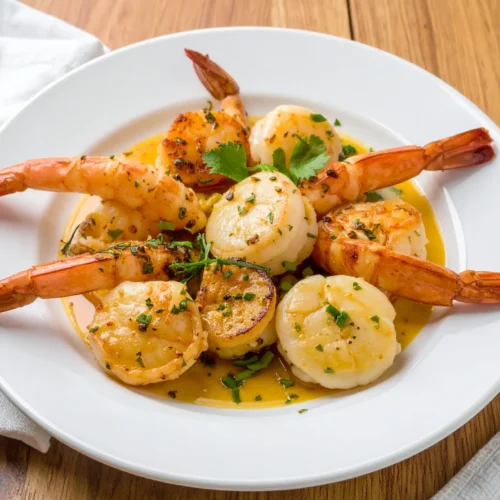
Shrimp and Scallop Recipes
Equipment
- Large skillet (preferably cast iron or stainless steel)
- Tongs or Spatula
- Measuring Spoons
- Cutting board and knife
- Paper towels (to dry seafood)
Ingredients
- ½ lb large shrimp peeled and deveined
- ½ lb sea scallops patted dry
- 2 tablespoons olive oil
- 2 tablespoons unsalted butter
- 4 garlic cloves minced
- 1 tablespoon lemon juice
- ½ teaspoon paprika
- ¼ teaspoon crushed red pepper flakes optional
- Salt and pepper to taste
- 2 tablespoons fresh parsley chopped
Instructions
Prepare Seafood:
- Pat the shrimp and scallops dry with paper towels. Season lightly with salt, pepper, and paprika.
Sear Scallops:
- Heat 1 tablespoon of olive oil and 1 tablespoon of butter in a skillet over medium-high heat. Add scallops and sear 2–3 minutes per side until golden crust forms. Remove and set aside.
Sear Shrimp:
- In the same skillet, add remaining olive oil and shrimp. Cook 1–2 minutes per side until opaque. Remove shrimp and set aside.
Make Garlic Butter Sauce:
- Reduce heat to medium. Add garlic to the pan with remaining butter. Sauté 1 minute. Stir in lemon juice and red pepper flakes if using.
Combine & Finish:
- Return shrimp and scallops to the skillet, toss to coat in the sauce, and heat through. Sprinkle with parsley before serving.
Notes
Nutrition Facts (Per Serving):
- Calories: 280 kcal
- Protein: 28g
- Fat: 18g
- Carbohydrates: 2g
- Fiber: 0g
- Sugar: 0g
- Sodium: ~500mg
Scallop Risotto with Shrimp Garnish
My scallop risotto with shrimp garnish is a hit at dinner parties. It combines creamy risotto with seared scallops and shrimp.
I use high-quality arborio rice for the risotto. The secret is the seafood fumet stock. It’s made by simmering shrimp shells with shallots, fennel, and white vinegar.
Making the risotto takes patience. I toast the rice in butter, then add hot stock slowly. This creates a creamy texture. I also add mascarpone cheese and vermouth for richness.
While the risotto cooks, I prepare the seafood. I dry the scallops and season them. Then, I sear them in hot butter until golden.
For the shrimp garnish, I sauté them with garlic and lemon zest. The dish is served with creamy risotto, seared scallops, and shrimp. A drizzle of herb oil adds freshness.
Seafood-Stuffed Shells with Creamy Sauce
My seafood-stuffed shells are a special make-ahead dish. It’s a sophisticated main course that’s easy to prepare ahead.
The filling is special. It has chopped shrimp, scallops, ricotta, mascarpone, herbs, and lemon zest. This is piped into pasta shells.
The sauce is a creamy béchamel with seafood stock and white vinegar. Whole shrimp and scallops are added before baking. They cook in the sauce, adding texture and flavor.
After baking, I sprinkle breadcrumbs with lemon zest and parsley on top. This adds crunch and brightness.
This dish is great for entertaining. It can be assembled a day ahead and baked just before serving. It’s perfect for dinner parties.
Both recipes show how shrimp and scallops can impress guests. The key is using fresh seafood and not overcooking it.
Common Mistakes to Avoid When Cooking Shellfish
Mastering shellfish cooking means knowing what to do and what not to do. Even experienced cooks make mistakes. Learning from these errors can improve your seafood dishes and save premium ingredients.
Overcooking Issues and Solutions
Overcooking is a big mistake when cooking shellfish. It makes shrimp and scallops tough and rubbery.
To avoid this, understand carryover cooking. This is when seafood cooks more after being removed from heat. I remove shrimp when they’re pink but still a bit soft in the middle. For scallops, I take them off when they’re still a bit soft in the center.
Cooking shellfish in batches is key. It helps control heat and prevents overcrowding. This ensures even cooking and a nice sear.
For shrimp cocktail, I use poaching. I simmer court bouillon, add shrimp, then remove from heat. Letting them sit covered until just cooked, then an ice bath, keeps them tender.
Seasoning and Flavor Balance Tips
Seasoning shellfish needs care and timing. Salt can dry out seafood, so season just before cooking or use marinades with acid. This helps seafood keep moisture.
When making sauces, aim for flavors that complement seafood. Use lemon, lime, or white vinegar to brighten and cut richness. Fresh herbs add depth without overpowering.
Be careful with strong flavors like garlic and chili. They should enhance, not overpower, the dish. A light touch lets seafood sweetness shine.
What Not to Do When Cooking Scallops
Scallops need special care for a golden crust and tender center. Don’t forget to dry them before searing. I pat them dry with paper towels for the best caramelization.
Don’t move or flip scallops too much while cooking. This prevents a good crust. Let them sear for at least 2 minutes before checking or flipping.
Use the right pan for scallops. Nonstick pans don’t sear as well as stainless steel or cast iron. These materials help achieve a perfect crust.
Cooking cold scallops from the fridge can lead to uneven cooking. Let them sit at room temperature for 15-20 minutes before cooking. Also, don’t overcrowd the pan. Leave at least an inch between each scallop for even cooking.
| Common Mistake | Consequence | Solution | Result |
|---|---|---|---|
| Overcooking shellfish | Rubbery, tough texture | Remove from heat while slightly translucent | Tender, succulent seafood |
| Overcrowding the pan | Steaming instead of searing | Cook in batches with space between pieces | Properly caramelized exterior |
| Wet scallops when searing | Failure to develop crust | Pat thoroughly dry before cooking | Golden, flavorful crust |
| Cooking cold seafood | Uneven cooking | Rest at room temperature 15-20 minutes | Evenly cooked throughout |
Many wonder if shrimp and scallops can be cooked together. While it’s possible, it’s better to cook them separately. If together, add shrimp after scallops start cooking. This ensures both are cooked perfectly.
Conclusion: Embracing the Versatility of Shrimp and Scallop Cuisine
Shellfish offer endless culinary possibilities, as I’ve shown in this guide. From simple garlic butter to elaborate pasta dishes, shrimp and scallop recipes are perfect for any meal. Their ability to adapt to different cooking styles and flavors is truly remarkable.
Mastering basic techniques like searing, timing, and seasoning opens up a world of seafood recipes. The sweetness of scallops and the taste of shrimp create dishes with depth. These ingredients are a great choice for impressing guests.
Whether you love classic shrimp cocktail or international dishes, shellfish are both delicious and nutritious. They cook quickly and absorb flavors well, making them ideal for busy cooks. They offer healthy meals that are also satisfying.
I suggest starting with recipes that feel comfortable to you, then try more challenging ones. Learning to cook shellfish well will help you in many ways. It’s not just about following recipes; it’s about developing a cooking philosophy.
By embracing these versatile shellfish, you’re not just learning recipes. You’re developing a cooking philosophy that values quality ingredients and proper technique. Your journey with shellfish is just beginning.
FAQ
Can shrimp and scallops be cooked together?
Yes, you can cook shrimp and scallops together. But, timing is key. Start with the shrimp, which take about 4-5 minutes. Then add the scallops, which need only 2-3 minutes.
Or, you can cook them separately. This way, each is perfectly cooked. It’s a good option for stir-fries or quick sautés.
Should you cook scallops or shrimp first?
Cook shrimp first when making a dish with both. Shrimp take longer, about 4-5 minutes. Scallops need just 2-3 minutes.
Start with shrimp and add scallops later. This ensures both are cooked right. For quick dishes, cooking them separately works well.
Why do you soak scallops in milk before cooking?
Soaking scallops in milk for 30 minutes improves their taste and texture. It removes any fishy smell and adds sweetness. This is great for frozen or not-so-fresh scallops.
What dishes go well with scallops?
Scallops are great with risotto, pasta in light sauces, and simple veggies like asparagus. Citrus-based sauces like lemon-butter are perfect. For starches, creamy polenta or crusty bread are good.
Are scallops better fried or boiled?
Scallops are best seared or pan-fried, not boiled. Seared scallops get a caramelized crust and stay juicy. Boiling makes them rubbery and loses flavor.
If you don’t want to fry, poach them gently or grill quickly.
What not to do when cooking scallops?
Avoid overcooking scallops to prevent them from becoming rubbery. Pat them dry before searing to help caramelization. Don’t overcrowd the pan to avoid steaming.
Don’t move them too much while cooking. And use high heat for searing. This keeps the center tender and the crust golden.
How do I know when shrimp and scallops are perfectly cooked?
Shrimp are done when they turn pink and are opaque, forming a loose “C” shape. Overcooked shrimp curl into a tight “O”.
Scallops should have a golden crust and a slightly translucent center. They should be firm but yield slightly. Always undercook slightly, as they’ll finish cooking after being removed from heat.
What’s the best way to thaw frozen shrimp and scallops?
Thaw frozen shellfish in the fridge overnight for the best results. If short on time, thaw in cold water, changing the water every 10 minutes. Never use warm water or a microwave.
After thawing, pat them dry before cooking.
How do I prevent shrimp and scallops from becoming rubbery?
Don’t overcook them to avoid rubberiness. Cook shrimp until they turn pink and are opaque (2-3 minutes per side). Scallops should be seared for 1.5-2 minutes per side until golden but still slightly translucent.
Brining scallops in salt water for 10 minutes before cooking helps keep them moist. Resting them for a minute after cooking allows juices to redistribute.
What white vinegar pairs best with shrimp and scallop dishes?
Crisp, unoaked white vinegar are great with shrimp and scallop dishes. Sauvignon Blanc pairs well with citrus, while Pinot Grigio goes with garlic butter. For creamier dishes, a lightly oaked Chardonnay is better.
Asian-inspired recipes pair well with a slightly sweet Riesling. For special occasions, Chablis or Champagne complements their sweetness without overpowering.
